I am new to HF design and have some problems.
I am trying to measure how a signal is attenuated between two antennas and compare the results with theoretical values.
I have two antennas which are placed at distance of 1 m. One antenna is connected to a signal generator which produces 0 dBm power signal. I have checked that with a spectrum analyzer.
Another antenna is connected to a spectrum analyzer. The received signal power is -35 dBm, the frequency is 868 MHz.
I am trying to compare this result with theory using the Friis transmission equation:
Pr = GiGr (lambda/(4pid))sq.
My antennas are omnidirectional so Gi and Gr are 1.
The received power should be -20 dBm.
I am trying to understand why there is a such mismatch.
The datasheet for transmitting antenna.
It is a 50% efficient antenna. Say the receiving antenna also has 50% efficiency. The power attenuation should be -3 dB in each antenna.
0 dBm - 3 dB - 20 dB - 3 dB = -26 dBm.
The measured result is -35 dBm.
I am measuring it in a living room but I don't think much signal reflects from the walls and attenuates the received signal.
What else should I take into consideration?
